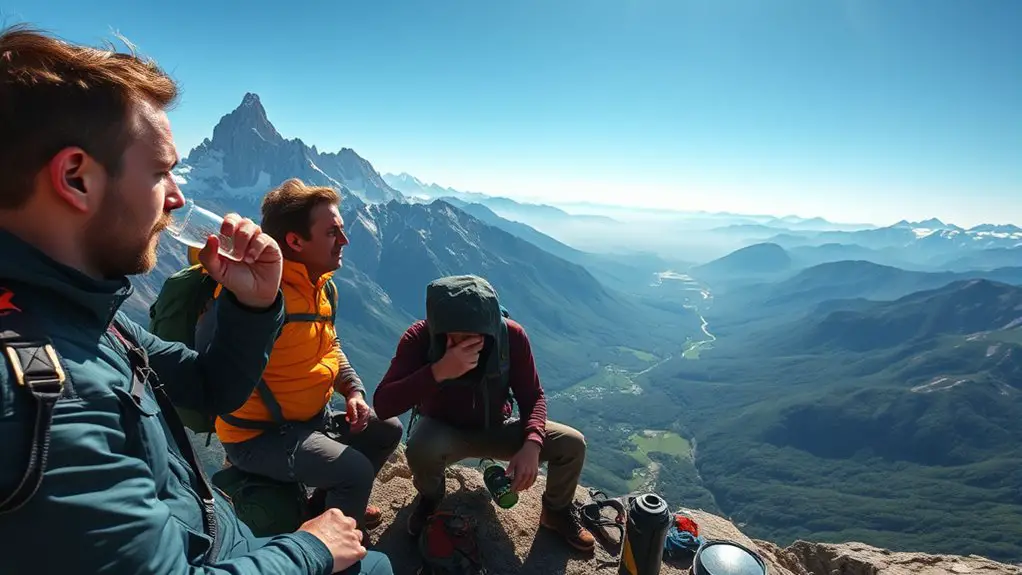To prevent altitude sickness during high-elevation sports, ascend gradually to allow your body to acclimatize. Hydrate consistently, drinking at least half a gallon of water daily, and focus on high-carbohydrate meals for energy. Listen to your body and recognize early symptoms like headaches and fatigue. Don't ignore these signs; if they worsen, descend to lower altitudes immediately. Staying fit also helps with adaptation. There's more to learn about effective strategies and emergency measures to keep you safe out there.
Understanding Altitude Sickness: Causes and Symptoms
When you ascend to high altitudes, your body can struggle to adjust to the decreased oxygen levels, which is what leads to altitude sickness. This condition can hit you unexpectedly, even if you're in great shape. You might experience headaches, dizziness, or fatigue, making you feel like you're trapped in a fog. Nausea and shortness of breath can also creep in, robbing you of your freedom to explore high peaks and breathtaking vistas.
Altitude sickness arises because your body's not getting enough oxygen to fuel your adventurous spirit. It can occur at elevations above 8,000 feet, but symptoms vary from person to person. Some folks adapt better than others. Listen to your body; if you start feeling off, don't ignore it. Ignoring these signs could lead to more severe conditions, like high altitude pulmonary edema (HAPE). Stay aware, and you can conquer those heights without being held back by altitude sickness.
Gradual Ascent: The Importance of Acclimatization
When you ascend to higher altitudes, your body needs time to adjust to the lower oxygen levels. This acclimatization process is essential in preventing altitude sickness, which can bring on a range of unpleasant symptoms. By understanding how to acclimatize properly, you'll be better equipped to enjoy your high-altitude adventures.
Acclimatization Process Explained
Acclimatization is essential for anyone venturing to high altitudes, as it allows your body to adjust to reduced oxygen levels. Instead of rushing to the summit, take your time. Gradual ascent is key—climb higher in increments, allowing your body to adapt. Spend a few days at a mid-elevation point, soaking in the freedom of the mountains while your body gets used to the thinner air. Stay hydrated and listen to your body's signals; it's all part of the adventure. Remember, it's not just about reaching the peak; it's about enjoying the journey. By respecting your body's need for acclimatization, you'll enhance your experience and keep the thrill of exploration alive without the burden of altitude sickness.
Symptoms of Altitude Sickness
As you ascend to higher altitudes, it's crucial to be aware of the symptoms of altitude sickness, which can sneak up on you if you're not careful. You might start feeling headaches, dizziness, or fatigue that seem out of the ordinary. Nausea and loss of appetite can also set in, making it hard to enjoy your adventure. Insomnia is common too, disrupting your night's rest. If you experience shortness of breath or an increased heart rate, don't ignore these signs. They signal your body's struggle to adapt. The key is to listen to yourself and descend if symptoms worsen. Prioritizing acclimatization can help you maintain that sense of freedom you crave while exploring those breathtaking heights.
Hydration Strategies: Staying Properly Hydrated
To stay properly hydrated at high altitudes, it's essential to drink plenty of water, especially since the air tends to be drier and you may lose fluids more quickly. Carry a reusable water bottle to make hydration easy and accessible. Aim for at least half a gallon a day, but listen to your body; you might need more, especially during intense activities.
Consider adding electrolyte tablets or powders to your water for added benefits. They help replenish essential minerals lost through sweat and can keep your energy up. If you're planning a long trek, set reminders to drink regularly, so you don't forget.
Also, be mindful of your environment. If you're sweating heavily or it's particularly sunny, increase your intake. Staying hydrated is key to enjoying your adventures at high elevation, giving you the freedom to explore without the worry of altitude sickness. Embrace the thrill of the mountains!
Nutrition Tips for High Altitude Activities
When you're heading to high altitudes, keeping your nutrition in check is just as important as staying hydrated. Fueling your body with the right foods can make a world of difference in how you feel and perform. Focus on consuming high-carbohydrate meals to give you the energy you need for those exhilarating climbs. Foods like whole grains, fruits, and veggies are great choices.
Don't forget about protein! It helps with muscle recovery and keeps your energy levels steady. Lean meats, nuts, and legumes should be on your menu. Also, consider packing snacks that are easy to carry—think energy bars or trail mix.
Lastly, listen to your body's cravings. If you're hungry for something specific, indulge wisely. Your body knows what it needs, so trust it. With the right nutrition, you can embrace the freedom of high-altitude adventures without feeling weighed down!
Recognizing the Early Signs of Altitude Sickness
When you're at high altitudes, it's essential to recognize the early signs of altitude sickness. Common symptoms like headaches and nausea can sneak up on you, so staying alert is key. If you notice these signs, knowing when to seek help can make all the difference in your experience.
Common Symptoms to Watch
Altitude sickness can hit you unexpectedly, but recognizing the early signs is essential for prevention. You might experience headaches, dizziness, or nausea as your body struggles to adapt to the thin air. Fatigue can set in quickly, leaving you feeling unusually drained. Pay attention to any shortness of breath during simple activities; it's a signal that your body's not adjusting well. Insomnia can also creep in, making it hard to enjoy the freedom of your adventure. Don't ignore these symptoms—your body's telling you something important. By staying aware of how you feel, you can take steps to alleviate discomfort and enjoy the heights you've dreamed of conquering without being held back by altitude sickness.
Importance of Early Detection
Recognizing the early signs of altitude sickness is essential, as prompt detection can make a significant difference in your health and overall experience. When you're out exploring high elevations, listen to your body. Symptoms like headaches, dizziness, or fatigue can signal that you're starting to feel the effects of altitude. It's vital to pay attention to these warnings. Ignoring them might lead to more severe issues, which can put a damper on your adventure. By catching symptoms early, you can take action—whether it's resting, hydrating, or descending to a lower altitude. You don't want to miss out on the freedom of the mountains, so stay attuned to how you feel and prioritize your well-being. Adventure awaits, but safety comes first!
When to Seek Help
How can you tell if your body is struggling with the effects of high elevation? Pay attention to early signs like headaches, nausea, and fatigue. If you notice shortness of breath or dizziness, it's a signal to take it seriously. You might feel a bit off or notice trouble sleeping—those aren't just normal discomforts at altitude. It's crucial to listen to your body and acknowledge these warnings. Don't push through; the freedom of the mountains isn't worth risking your health. If symptoms worsen or you experience confusion, it's time to seek help. Descend to a lower elevation, hydrate, and rest. Prioritizing your well-being guarantees you can enjoy your adventures without being sidelined by altitude sickness.
Medication Options for Altitude Sickness Prevention
When planning a trip to high elevations, considering medication options for preventing altitude sickness can be a smart move. Acetazolamide, often known as Diamox, is a popular choice. It helps speed up your body's acclimatization process by promoting breathing and fluid balance. Taking it a day before you ascend and continuing for a couple of days at altitude can make a real difference.
Dexamethasone is another option, especially if you're susceptible to severe symptoms. It's a corticosteroid that can help reduce inflammation and pressure in your brain. However, it's best used under medical guidance.
The Role of Physical Fitness in Altitude Adaptation
Here's a quick comparison of fitness levels and their effects on altitude adaptation:
| Fitness Level | Adaptation Speed | Symptoms Experienced |
|---|---|---|
| Sedentary | Slower adaptation | More severe symptoms |
| Moderately Fit | Moderate adaptation | Mild symptoms |
| Well-Fit | Faster adaptation | Few to no symptoms |
| Elite Athletes | Quickest adaptation | Rarely experience symptoms |
When you incorporate regular cardio and strength training into your routine, you're setting yourself up for success. Strength training enhances power, speed, and agility, making it easier to handle the challenges of altitude. Embrace the freedom of movement and enjoy your high-elevation adventures with confidence!
Choosing the Right Gear for High-Elevation Sports
Choosing the right gear for high-elevation sports is vital, as the right equipment can make all the difference in your performance and safety. When you're out there chasing freedom in the mountains, you want to be prepared. Here are three key items to take into account:
- Footwear: Invest in high-quality, breathable hiking boots or shoes with good traction. They'll keep your feet comfortable and stable on varying terrain.
- Layered Clothing: Opt for moisture-wicking base layers, insulating mid-layers, and a waterproof outer shell. This combo helps you regulate body temperature and stay dry, vital for avoiding altitude sickness.
- Hydration System: Carry a hydration pack or water bottles that're easy to access. Staying hydrated at high elevations is essential for maintaining energy and preventing altitude-related issues. Proper hydration helps to avoid fatigue and cramps, which can be exacerbated by high altitude.
With the right gear, you're ready to embrace the mountains and enjoy every moment of your adventure!
Emergency Measures: What to Do If Symptoms Occur
Altitude sickness can strike unexpectedly, so knowing what to do if symptoms occur is essential for your safety and well-being. If you start feeling dizzy, nauseous, or experience a headache, don't ignore it. First, stop your activity and descend to a lower elevation immediately. Even a few hundred meters can make a difference.
Stay hydrated; drink plenty of water, but avoid alcohol and caffeine as they can worsen symptoms. Rest is vital—give your body time to adjust. If symptoms persist or worsen, seek medical help without delay.
Consider carrying a portable oxygen source if you're venturing into extreme altitudes, as it can provide quick relief. Remember, your spirit of adventure is important, but so is listening to your body. Always prioritize your health, so you can keep chasing those breathtaking views and exhilarating experiences. Stay safe, and enjoy the freedom of the mountains!
Frequently Asked Questions
Can Altitude Sickness Occur at Lower Elevations?
Ever felt a headache creeping in unexpectedly? Yes, altitude sickness can occur at lower elevations, especially if you're rapidly ascending or have specific health conditions. Staying aware of your body's signals keeps you free to enjoy your adventures.
How Long Does It Take to Acclimatize?
Acclimatizing usually takes a few days, but it varies. You might feel fine after just a couple, or it could take longer. Listen to your body, and give yourself the time you need to adjust.
Are Some People More Prone to Altitude Sickness?
Yes, some people are more prone to altitude sickness due to genetic factors, age, or previous experiences. If you've struggled before, you might want to take extra precautions when heading to high elevations.
What Are the Long-Term Effects of Altitude Sickness?
Imagine struggling to breathe, feeling your body betray you. Long-term effects of altitude sickness can include persistent headaches, fatigue, and even cognitive issues. It's essential to prioritize your health and adapt before those heights take their toll.
Can Altitude Sickness Affect Pets During High-Elevation Activities?
Yes, altitude sickness can affect pets during high-elevation activities. Just like you, they can struggle with lower oxygen levels. It's essential to monitor their behavior and guarantee they're acclimatized to avoid health issues.




